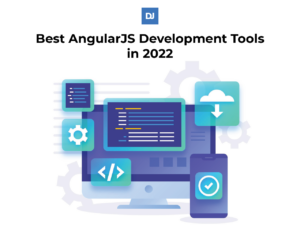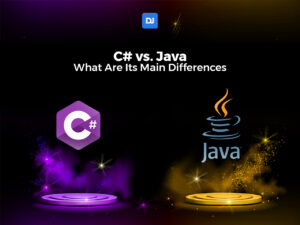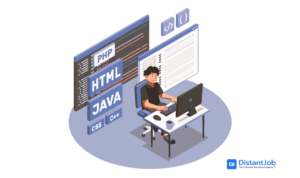Gone are the days when buying software for a company involved visiting an office supply store or waiting for a courier. With the advancement of SaaS cloud computing technology, there is no need to store disks or implement a software installation process.
SaaS (Software as a service) changes the rules of the game in the entire target sector, transforming it entirely and making it easier to use. This model, among other things, eliminates the need to install programs on a computer. Everything happens in the cloud – efficiently and conveniently. The industry is projected to reach an incredible $ 623 billion by 2023, with a compound annual growth rate of 18%.
In this article, we will take a closer look at this system, its advantages, problems, and development methodology.
Jump to:
- What is SaaS Software Development?
- Stages of the SaaS Software Development Life Cycle
- Why is it worth implementing a SaaS model in your business?
- Sample SaaS Applications
- SaaS Software Development Challenges and Ways to Overcome Them
- SaaS development methodologies
- Choosing a technology stack for SaaS
- SaaS solution types: horizontal or vertical
- Conclusion
What is SaaS Software Development?
SaaS is a cloud software sharing model in which a cloud provider develops and maintains all cloud applications. In addition, it provides automatic updates and makes the software available to its customers over the Internet on a pay-as-you-go basis. The cloud provider manages all hardware, middleware, application software, and security.
SaaS customers can significantly reduce costs, more accurately predict the total cost of ownership, deploy, scale, and update business solutions faster than on-premises systems and software maintenance.
In the early 2000s, the first generation of SaaS solutions was developed, capable of solving only one business problem at a time. Since then, the SaaS model has changed and evolved a lot.
Today’s cloud suite can encompass and link virtually everything from financial processes, human resources, procurement, and supply chains to commercial, marketing, sales, and service solutions.
Other benefits of a modern and complete SaaS solution include:
- Fully integrated and end-to-end business processes.
- Easy to configure and personalize.
- Faster data transfer.
- Comprehensive cloud security.
- Built-in analytical functions.
- Support for new technologies, from artificial intelligence (AI) to chatbots, the Internet of Things (IoT), and more.
The most popular examples are calendar, email, and various office tools. A company that uses a SaaS app regularly only pays for the software it actually uses. Netia offers its customers a comprehensive cloud service called Netia Compute, which allows you to manage huge databases and create backups.
Stages of the SaaS Software Development Life Cycle
A SaaS product in the context of its life cycle is significantly different from traditional software. It includes the following steps:

1. Performance
In the forecasting phase, the development of a SaaS project is identical to the development of other products. First, you need to assess the scale of the project from a business perspective. At this stage, it is very important that SaaS developers think critically because this approach will save you from possible failure. Everything should be discussed with investors, managers, marketers, and architects.
2. Grade
This is followed by the platform evaluation stage. It is important that the architecture and functionality of the cloud platform correspond to the specifics of the project and contribute to the realization of its goals. The platform needs to be powerful enough to provide scalability and disaster recovery.
3. Planning
The planning phase involves making all decisions that are significant for the SaaS project, which will further affect its implementation. At this stage, it is necessary to formalize the requirements for the terms of reference of the project. It is important that all stakeholders formalize this aspect. You should also plan the project and develop a roadmap. A risk mitigation strategy is another important area at this stage.
4. Subscription
The next step is to subscribe to your chosen cloud provider. At this stage, the final decisions on architecture and pricing are made. It is important that your subscription management strategy is worked out to the smallest detail. This phase also provides backups and possible disaster recovery.
5. Development
Development is the most time-consuming stage, but it is impossible to proceed to it until the previous ones are completed. At this stage, the development environment is set up, testing is carried out, functionality and security policy are added. Also, issues related to synchronization and testing of support services are being resolved.
6. Operations
Upon completion, the operational stage follows – that is, the operation. It is worth checking all the key features of the product and how well the employees work with it. You may have to make additional improvements and improvements, fix bugs, and re-check the system. These are mandatory items that must not be overlooked.
If you follow this sequence, it will greatly increase the project’s chances of success.
Why is it worth implementing a SaaS model in your business?
Implementing a SaaS model in any area of business is convenient, here’s why.
Technology mobility
Due to the pandemic, many companies have moved to work from home, some have returned to the office, and some have completely changed the format. Most traditional technologies seem to tie workers to office chairs.
The implementation of the SaaS cloud model allows employees to access software, tools, and applications remotely from anywhere in the world and from any device that supports them.
Sparingly
SaaS technology does not require overpayment for unused programs, eliminates the need to purchase a large number of applications and install expensive software. In addition, it does not require additional maintenance and upgrade costs. The company only pays for the programs it needs.
Convenient update
Save money and provide additional convenience – a one-way upgrade. The service provider implements it himself, and customers always use the latest version of the software. The feature is already included in the SaaS package.
Simple interface
The SaaS application interface is available on mobile devices, laptops, and PCs. It is easy to operate and therefore requires minimal training. Thanks to the internal customization capabilities, the company can improve it according to the individual requirements of the company.
Data storage
With SaaS technology, there is no need to install additional expensive storage for backups. All information is stored in the cloud, so it is easy to recover it, and for this, it is enough to have unique credentials. You yourself can choose the required amount of storage and adjust it in the process.
Security
SaaS cloud storage keeps your data safe. In the event of a cyberattack, it will target the server or computers, but not the storage data.
Sample SaaS Applications
Well-known and reliable SaaS products include:
- Slack: It is a business messenger that greatly simplifies the communication process and increases the efficiency of interaction between employees. It is chosen by companies all over the world.
- Trello: Product based on the Kanban project planning methodology. Wide functionality allows you to manage actions flexibly and track the stages of projects.
- Buffer: Created specifically to improve the efficiency of working with social networks. With it, you can make delayed posts, measure performance, and improve your social media marketing.
Also, great examples of products using SaaS are Zoho, Mailchimp, Google Drive, and Shopify.
SaaS Software Development Challenges and Ways to Overcome Them
There are 4 main development challenges: choosing a team to develop the application, secure SaaS access, payment functionality, and system availability.
No. 1. Team
A reliable partner is key to obtaining a quality product. A good SaaS development team is built by the following people:
- The Solution Architect is the “head” of the team that will create the basic framework for the product.
- Project manager – conducts major negotiations with companies, makes decisions, signs agreements, etc.
- Software developers – write code.
- DevOps is a specialist who integrates system components and works with the server.
- Testers are engaged in checking the health of the system.
At the first meeting, you will immediately understand who is in front of you – a professional or a beginner. A good development team will immediately show interest in conducting a detailed examination of your product to create the perfect software.
No. 2. Security
Securing SaaS is a top priority for developers. They should pay a lot of attention and time to data encryption, excluding the possibility of phishing attacks on system users. The security system must comply with international standards.
Cloud security is more difficult to implement, so it is important to be handled by professionals in their field. There are additional tools worth investing in. For example, Cloud Security Posture Management (CSPM) and Cloud Workload Protection (CWP). They will help protect storage, data and secure the main channels of exposure.
No. 3. Integration of third-party payments
Most companies will have to supplement the system with a third-party payment service. Full integration of the payment system also falls on the shoulders of the developers. This can take a lot of time because the creation of the service must be planned, all integration-related problems must be resolved, and several manual and automated tests must be performed.
No. 4. Deployment with zero downtime
The new system is not always available to all users of the company at once. To solve this problem, developers often resort to implementing a zero-downtime deployment strategy. This will allow the system to respond smoothly to all requests within a given time.
For this problem, there are also additional tools that can solve it, but they will require additional funds.
SaaS development methodologies
Currently, there are several software development methodologies. They are used to applying to all projects, including the SaaS development process. A list with a description of their features:
- Waterfall. The waterfall model works consistently, so the design team has no way to move on to the next stage of development or testing until the previous step has been successfully completed.
- Agile. This is a practice that requires constant repetition of development and testing as you develop software. In this model, unlike a waterfall, we conduct both development and testing overnight. This process automatically leads to closer communication between customers, developers, managers, and testers.
- Scrum. An additional layer for Agile that implements sprint latency, scheduling, and retrospectives.
- Rapid application development. A prototype is quickly assembled from ready-made templates to speed up development and then tested.
- Iterative. Small-scale development followed by scalable iterations.
- Spiral. Development is divided into cycles, each of which is evaluated in order to influence the next cycle and the best methodology subsequently.
Despite the fact that Agile and Scrum are the most popular methodologies, each of these has its own strengths that can be applied in development.
Choosing a technology stack for SaaS
To maintain an optimal software ecosystem and ease the development environment, you must choose the right technology stack. Give a categorical answer to the question “what exactly is right?” it is forbidden. Choose them based on company requirements, internal and external factors, and performance. Several technologies for integration into SaaS:
- Artificial intelligence: AI is still a relatively new technology, and it is expected that this solution, along with adaptive intelligence, will increasingly be tied to enterprise SaaS programs.
- Autonomous information technology management: Artificial intelligence and machine learning will also play a vital role in enabling more autonomous and less human-dependent governance in the IT stack.
- Chatbots, Internet of Things, and Blockchain: Each of these technologies is becoming increasingly important for digital innovation. Prospective vendors are already finding ways to incorporate them into their SaaS solutions.
Each of them will facilitate the work of companies and improve the user experience.
SaaS solution types: horizontal or vertical
While the SaaS model was originally a way to deliver vertical solutions to one department quickly , it is increasingly required by enterprises that expect transparency in all of their business processes.
The vertical type is a group of software solutions that meet the requirements of the niche industry. In other words, vertical SaaS companies serve different needs of the same structure, such as retail, banking, healthcare, or hospitality. This model takes a more conservative approach to sales than the horizontal counterparts.
The horizontal type has low customer retention because it does not always meet industry requirements, cumbersome leadership roles, and has a high customer acquisition cost.
The horizontal solution model is versatile from an industry perspective, while the vertical solution model is much more personalized and customer-centric from a single structure, which is why the latter model is becoming a trend among SaaS products.
Conclusion
The SaaS system is an integral part of any business. This is necessary for both the company and its consumers. It facilitates the creation and operation of software and is also easy to use. In addition, it saves the company’s budget, which allows you to invest unspent funds for reinvestment.
We examined all the advantages of software development using SaaS, the development methodology, the main problems, and the prominent representatives of the world of applications who have already integrated the system. SaaS is the future, and this article proves it.
And if you are looking to hire an online software developer, you came to the right place. Contact us and will help find you a programmer in less than 2 weeks.





